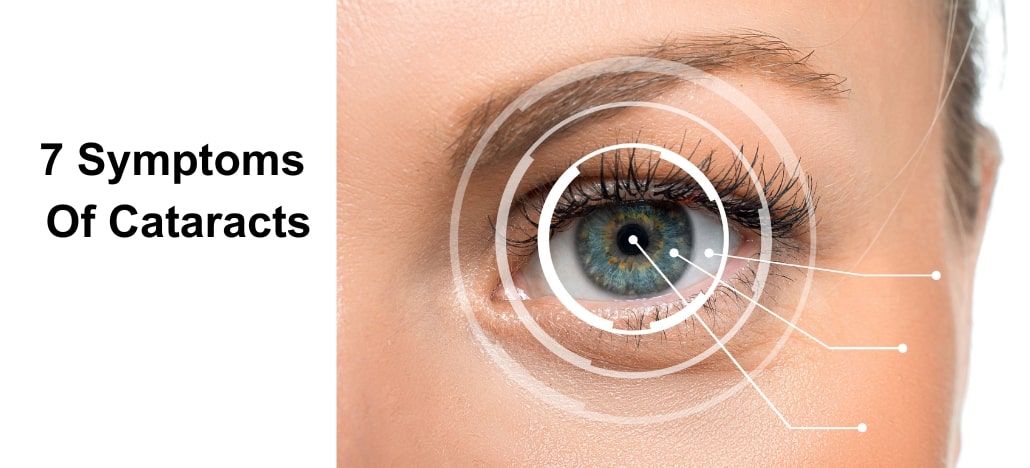
7 Symptoms of Cataracts
Cataracts develop when proteins in the lens of the eye break down and clump together, leading to clouding of the lens and obstructing vision. This eye condition can occur at any age but primarily affects older adults. Recognizing the symptoms of cataracts early is crucial for maintaining eye health and preventing significant vision loss. The symptoms of cataracts can vary depending on the type of cataract and its location within the lens.
What Are the 7 Symptoms of Cataracts?
Cataracts develop gradually over time, causing the clouding of the lens that can result in various visual impairments. The types of cataracts include nuclear cataracts, cortical cataracts, and posterior subcapsular cataracts. Each type causes different symptoms but shares a common feature: the clouding of the lens, which can obstruct vision. Cataracts can cause a range of symptoms, from mild blurring to severe vision impairment. As cataracts develop, they often cause clouding of the lens that leads to difficulty seeing clearly. The presence of these symptoms typically prompts individuals to seek an eye exam for a comprehensive assessment. An eye doctor can diagnose cataracts through a thorough examination and provide information on the types of cataracts and their specific impact on vision.
Clouded, Blurred, or Dim Vision
One of the earliest and most common symptoms of cataracts is clouded, blurred, or dim vision. This symptom occurs as the cataracts develop, leading to a progressive clouding of the lens that scatters light and reduces the sharpness of visual images. Initially, the changes in vision may be subtle, but over time, the clouding of the lens can worsen significantly. The clouding of the lens causes a general haze that can make it difficult to see clearly, affecting everyday tasks such as reading or recognizing faces. As cataracts continue to develop, the clouding of the lens can become more pronounced, leading to more severe vision impairment. The clouding typically affects the center of the lens, causing light to scatter and reducing overall visual clarity.
Trouble Seeing at Night
Cataracts often cause trouble seeing at night, which can be particularly problematic for activities such as driving at night. This symptom arises because the clouding of the lens scatters light, increasing glare from oncoming headlights and streetlights. Individuals with cataracts may notice that their vision becomes particularly poor in low-light conditions, making it challenging to navigate and increasing the risk of accidents. The clouding of the lens reduces contrast sensitivity, making it difficult to distinguish between objects and their backgrounds, especially in the dark. Night vision becomes impaired as the cataracts develop further, leading to increased difficulty in activities that require good low-light vision.
Sensitivity to Light and Glare
Increased sensitivity to light and glare is a common symptom of cataracts. This sensitivity can make it uncomfortable to be in bright environments or to face direct sunlight. The clouding of the lens scatters incoming light, causing a significant increase in glare that can be both painful and disorienting. People with cataracts often find it necessary to wear sunglasses or avoid situations with intense lighting to reduce discomfort and improve visibility. Sensitivity to light can also make it difficult to see clearly indoors if the lighting is too bright, impacting daily activities. As cataracts develop, the clouding of the lens makes it more challenging to tolerate bright lights and increases the discomfort associated with glare.
Need for Brighter Light for Reading and Other Activities
As cataracts progress, individuals may notice a need for brighter light for reading and other close-up tasks. The clouding of the lens reduces the amount of light that reaches the retina, making it more challenging to see fine details. This symptom often leads people to seek out additional lighting sources or use a magnifying glass to improve their ability to read small print or perform detailed work. The increased need for brighter light is one of the first signs of cataracts and often prompts individuals to schedule an eye exam. During the eye exam, an eye doctor can assess the extent of the cataracts and recommend appropriate treatment options. The need for brighter light can become more pronounced as the cataracts develop further, affecting the ability to perform daily activities that require good vision.
Seeing “Halos” Around Lights
Seeing halos around lights is a classic symptom of cataracts. This phenomenon occurs because the clouding of the lens diffuses incoming light, creating a ring-like effect around bright sources. Halos are most noticeable at night, especially around headlights and streetlights, and can significantly impair vision while driving at night. The appearance of halos can be disorienting and is a strong indicator that the lens of the eye is becoming increasingly clouded. This symptom can also affect other aspects of vision, making it difficult to see clearly in various lighting conditions. As cataracts develop, the clouding of the lens causes more light scattering, leading to a more pronounced halo effect around lights.
Frequent Changes in Eyeglass or Contact Lens Prescription
Frequent changes in eyeglass or contact lens prescription can indicate the presence of cataracts. As the lens becomes clouded, vision deteriorates, leading individuals to seek more frequent adjustments to their prescriptions. This can be frustrating for those who find that their vision continues to change even with new prescriptions. Regular eye exams are essential for monitoring these changes and determining the appropriate time for cataract surgery. Surgery is the only effective treatment for cataracts, as it involves removing the clouded lens and replacing it with an artificial lens, restoring clear vision. Frequent changes in prescription are often a sign that cataracts are progressing and that the clouding of the lens is worsening.
Fading or Yellowing of Colors
Cataracts can cause colors to fade or take on a yellowing hue. The clouding of the lens acts as a filter, dulling the vibrancy of colors and making them appear less distinct. This symptom affects daily activities such as choosing clothing, preparing food, or enjoying hobbies that rely on accurate color perception. Over time, the yellowing of the lens can become more pronounced, further reducing the ability to distinguish between colors accurately. The clouding of the lens associated with cataracts is responsible for the fading and yellowing of colors, making it more challenging to see clearly and appreciate the true colors of objects.
FAQ
Will I need to wear glasses after cataract surgery?
This depends on the artificial lens placed during surgery and the condition of your eye. Some patients may continue to wear glasses for distance or near vision after surgery.
What is the recovery process like after cataract surgery?
The healing process usually takes several weeks. You may need to use eye drops after surgery and it is important to follow your doctor’s recommendations. Vision usually begins to improve within a few days.
Our Bestsellers
Categories
Company
Media
Follow Us
© Copyright Biotech /Terms Of Use - Privacy Policy
Version 2_CT_1212222



